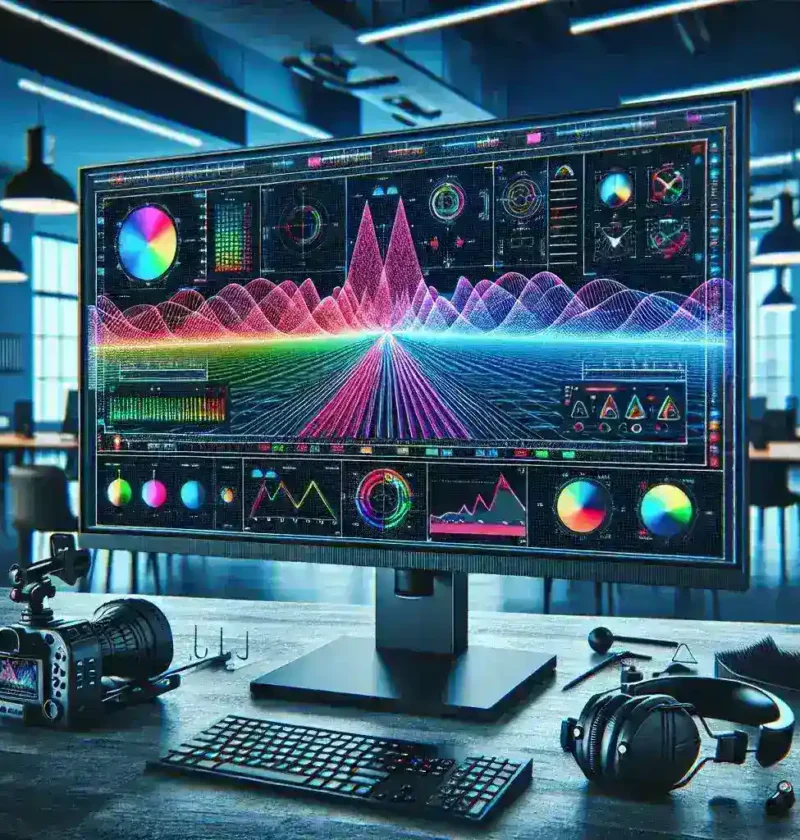Professional monitors equipped with hardware-level video scopes are essential tools in the world of video production and post-production. These high-end monitors are pivotal for ensuring the best quality output, delivering precise details, and maintaining color accuracy throughout the processing pipeline. This article will discuss the significance of hardware-level video scopes, their features, and why they are so crucial for professionals in the industry.
What are Hardware-Level Video Scopes?
Hardware-level video scopes are built-in tools within professional monitors that provide real-time analysis of video signals. These scopes offer various functions such as waveform monitoring, vector scope analysis, and histogram assessments.
Types of Video Scopes Found in Professional Monitors
| Type of Video Scope | Description |
|---|---|
| Waveform Monitor | Displays the luma (brightness) and chroma (color) information of a video signal. |
| Vector Scope | Shows the chrominance information, allowing for precise color adjustments. |
| Histogram | Represents the distribution of pixel intensity levels in an image. |
Importance of Hardware-Level Video Scopes in Professional Monitors
A myriad of reasons support the integration of these tools into professional monitors. Let’s dive into the main factors:
1. Real-Time Accurate Analysis
Hardware-level video scopes provide real-time analysis, critical for making instant decisions about video quality and adjustments. These tools ensure that the final video output maintains the desired quality without artifacts or errors.
2. Enhanced Color Precision
Professional monitors with integrated scopes aid in achieving unparalleled color accuracy. The ability to make precise color corrections ensures that the final output aligns with industry standards, which is crucial for broadcast and cinema productions.
3. Improved Workflow Efficiency
Integrating video scopes directly into the monitor streamlines the workflow. Professionals no longer need to rely on external tools or software, which can cause delays and potential inaccuracies. Embedded scopes result in a more efficient and seamless operation.
4. Advanced Troubleshooting Capabilities
Video scopes can instantly identify issues within the video signal, such as exposure problems, color imbalances, or signal clipping. This immediate feedback allows for quick troubleshooting and rectifications, saving time and resources.
Key Features of Monitors with Hardware-Level Video Scopes
Professional monitors that come with built-in video scopes boast several advanced features, making them ideal for high-end video production:
- High Resolution: Offers crystal-clear display quality, essential for detailed video analysis.
- Wide Color Gamut: Supports a broader range of colors, ensuring more precise and vibrant display.
- High Dynamic Range (HDR) Support: Provides deeper blacks and brighter whites, enhancing the overall viewing experience.
- Multiple Inputs: Facilitates various video sources, making it adaptable for different production environments.
- Calibration Tools: Ensures the monitor remains color-accurate through regular calibrations.
Applications of Hardware-Level Video Scopes
The use of monitors with embedded video scopes spans across various sectors of video production:
Broadcasting
Broadcast professionals rely heavily on color precision and signal integrity. Video scopes assist in ensuring broadcast standards are met without sacrificing quality. They help in real-time monitoring of live shows, sports events, and news broadcasts.
Film Production
Color grading is a critical part of film production. Monitors with built-in scopes enable colorists to make precise adjustments, aligning the visual output with the director’s vision. They also assist in ensuring continuity across scenes.
Post-Production
Post-production requires meticulous attention to detail. Embedded video scopes allow editors to fine-tune video elements, ensuring a polished final product. The scopes are indispensable for tasks like color correction, luma adjustments, and signal verification.
Live Events
For live events, instant feedback on video quality is crucial. Monitors with video scopes provide real-time analysis and adjustments, ensuring the audience experiences the best visual quality throughout the event.
Choosing the Right Professional Monitor
When selecting a professional monitor with hardware-level video scopes, consider the following factors:
Resolution
Higher resolution monitors offer superior detail and clarity, essential for analyzing video quality.
Color Accuracy
Look for monitors that provide excellent color reproduction and support for wide color gamuts and HDR.
Scope Functionality
Ensure the monitor includes the specific scopes required for your workflow, such as waveform, vector, and histogram.
Connectivity
Evaluate the input and output options to ensure compatibility with existing equipment.
Reliability
Opt for monitors from reputable brands known for their reliability and customer support.
Conclusion
Professional monitors equipped with hardware-level video scopes are a cornerstone in achieving high-quality video production. They offer real-time analysis, heightened color accuracy, and streamlined workflows, making them invaluable tools for professionals. Whether for broadcasting, film production, or live events, these monitors ensure that the visual output meets the highest industry standards.

